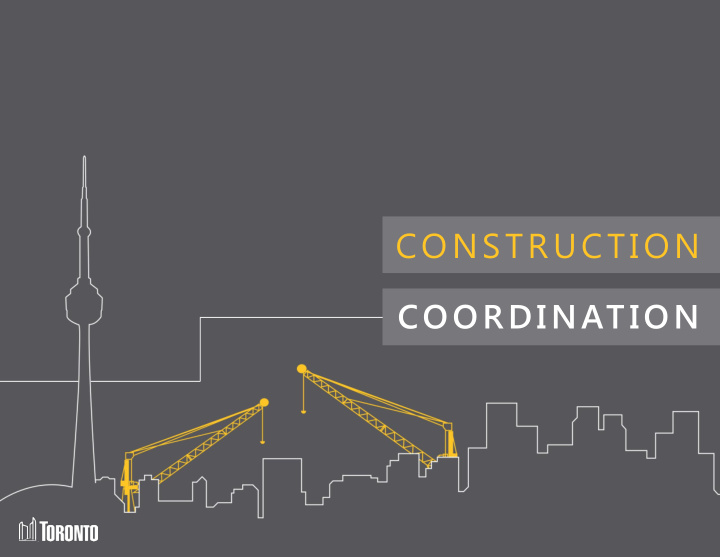



CONSTRUCTION COORDINATION
BOOM CONSTRUCTION The City of Toronto is undergoing an unprecedented construction boom Toronto is recognized as a great place to live, work, and do business . The city has rapidly grown to become North America’s fourth largest city. Toronto’s construction boom shows that the city is healthy and the economy is growing . This increased construction activity requires careful coordination .
CONSTRUCTION WHY? updates to aging infrastructure Transportation Services, Toronto Water and the TTC are updating a significant amount roads of their infrastructure across bridges the city, built 60-70 years ago and currently reaching the end of its service life. Upgrades ensure road networks are repaired , transportation and public transit corridors improved , water and watermains and sewers are replaced or rehabilitated . transit
CONSTRUCTION WHY? extensive private construction The city is growing at a tremendous rate, particularly the downtown core. There are significant demands for new infrastructure to support residential and commercial development across the city. Private construction increases demand for services and adds further pressure to our roads.
WHY? CONSTRUCTION upgrades to externally owned utilities External organizations including Toronto Hydro, Enbridge, Enwave and various telecom companies require access to their underground infrastructure to expand and upgrade their utilities. The city is legally required to allow external utilities access to their infrastructure, adding to disruption on our roads.
CONSTRUCTION CONGESTION The unprecedented growth the pressure on our roads is intense of the City of Toronto and the accompanying upgrades to services to support this growth, is resulting in delays and disruptions to the City’s travelling public. The public at large is feeling significant frustration with challenges to traffic flow caused by construction work.
CONSTRUCTION COORDINATION Some believe the City does not challenges to coordination efforts coordinate construction work. This is a MYTH . Construction work is highly choreographed and the City takes effective Construction Work Practices are Policies & Protocols Governed By : and responsible action to ensure the longevity and quality of city infrastructure. Noise bylaws Short construction season Contractor prices Labour availability Laws allowing utilities Private construction underground access lane closures
CONSTRUCTION COORDINATION The City is working hard to short-term solutions improve the coordination and management of construction work zones across the city. Signal Timing Accelerating Work When work begins on any Implementing traffic signal Investigating methods to construction projects, the city timing changes on roads near accelerate work, such as future to where work is occurring to work on the Gardiner being makes every effort to minimize enhance traffic flow. reduced from 20 to 12 years. disruption wherever possible. Alternate Routes Parallel Streets Constantly reviewing and Avoiding having construction monitoring traffic impacts on work done on parallel streets alternate routes to update to minimize impacts on traffic public on travelling options. to motorists. Off-Peak Hours 5-Year Moratorium Time work to take place in Impose a moratorium on off-peak hours where possible future tearing up of the same to minimize disruptions to the road, except for emergencies travelling public. for a period of five years.
CONSTRUCTION COORDINATION The City is implementing long-term solutions several long-term strategies for managing construction work. The Major Capital Putting the Coordination Puzzle Together Infrastructure Coordination The Major Infrastructure Coordination Office brings together all groups Office will be responsible for that perform construction work in the city. The MCIC has developed new systems to plan projects city-wide five years in advance, and manage coordinating infrastructure changes in scope of work as projects move closer to construction. projects city-wide. Improved Communication Initiatives The MCIC is also improving communication between the City’s divisions, such as Transportation, Engineering, and Construction, and all external agencies across the city, ensuring all groups are aware of what other organizations are doing, and can plan accordingly. Bundling Together Infrastructure Projects The MCIC’s efforts result in cost -savings by bundling different projects together to ensure work is done in the right order at the right time. This expanded coordination effort results in less construction disruptions and avoiding repeated tearing up of the same street by different organizations.
CONSTRUCTION COORDINATION The City’s coordination moving forward together challenge is to renew urban infrastructure in a growing city that never sleeps. Careful coordination of infrastructure It is clear the City of Toronto faces a number of challenges to get all projects results in maintaining critical construction work completed while accommodating the competing a high quality of life and interests on and under our busy roadways. The effective implementation of coordination strategies aims to alleviate congestion in our city. economic performance. While the city is making every possible effort to minimize disruptions to the public, there in no denying that delays will occur. Emergency work, for example must be done and roads need to be closed for safety reasons. However, the city continues to take significant steps toward getting this important work done effectively through its short-term and long-term coordination plans.
@TorontoComms www.toronto.ca
Recommend
More recommend